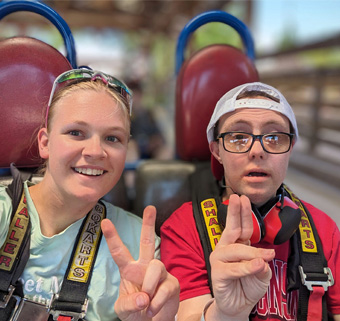The Story of Beautiful Girl
| January 2012Along with a new calendar, every New Year’s brings dozens of suggestions for resolutions. Rather than add to the list, I’m recommending you start this year by reading a certain book – The Story of Beautiful Girl by Rachel Simon. It’s a sensitive and, yes, beautiful novel about a girl with developmental disabilities who was institutionalized during the 1960s and the people around her.
I recently discovered the press release that follows on ANCOR’s website. It intrigued me enough to get the book. After reading just the first paragraph I was hooked and read it in every spare moment over the next three days. After that I got a copy of Rachel Simon’s earlier memoir, Riding the Bus with My Sister – also an excellent and enlightening read.
I went on a hunt for other developmental disability stories of a similar nature and found this incredible resource of books and documentaries: I hope you’ll reply and let me, and the readers of this blog, know of other good books (fiction or non-fiction) on the topic of people living with disabilities.
So start this year by connecting with your heart – through The Story of Beautiful Girl.
About the Story of Beautiful Girl by Rachel Simon
Below is the original press release put out by ANCOR. It gives details on the background of the book and information on where to purchase it.
 ANCOR Applauds the Release of The Story of Beautiful Girl
ANCOR Applauds the Release of The Story of Beautiful Girl
New Novel Showcases the Value of Community Living for People with Disabilities
(Alexandria, VA – May 4, 2011) The American Network of Community Options and Resources (ANCOR), celebrates the release today of the novel, The Story of Beautiful Girl, by Rachel Simon. Best known for her memoir, Riding the Bus with My Sister, Simon calls upon her intimate familiarity with people with disabilities to capture their spirit and free will.
The Story of Beautiful Girl tells the tale of two individuals, a woman with an intellectual disability and a deaf man, who escape from an institution in Pennsylvania in 1968 with the woman’s newborn daughter. The story plays out over several decades, and includes many issues familiar to those in the disabilities field: the abuse and dehumanizing conditions in the institution, the advent of deinstitutionalization, and the value of dedicated Direct Support Professionals, who work to enhance the lives of people with disabilities. This account of triumph against the odds weaves in issues such as the right to community living, romance and sexuality, self-expression, spirituality and independence.
“This amazing story is a vivid illustration of many of the important issues our member agencies have been emphasizing for years,” says Renee Pietrangelo, ANCOR CEO. “People with disabilities have the right to lead fully integrated lives in communities of their choosing, and when we support those choices, the entire community benefits.”
Although many think of state institutions as relics of the past, there are still 162 state institutions in this country housing an average daily population of over 33,000 people. Only ten states and the District of Columbia have closed all their state institutions.[1] Inadequate funding has denied many individuals with disabilities access to the supports and services that make community living possible. There are currently over 300,000 people with disabilities on waiting lists for home and community based long term services and supports across the country. The average wait is 8-10 years.[2]
Useful Links
- Purchase The Story of Beautiful Girl from Amazon.com using this link and 6% of the proceeds will go to the ANCOR Foundation.
- Rachel Simon’s bio
- The first chapter of The Story of Beautiful Girl
- Rachel Simon’s website
References
[1] Lakin, K.C., Larson, S.A., Salmi, P., and A. Webster. (2010). Residential Services for Persons with Developmental Disabilities: Statues and trends through 2009. Minneapolis: University of Minnesota, Research and Training Center on Community Living, Institute on Community Integration.
[2] The Arc of the United States, website page on Public Policy: Medicaid Issues for People with Disabilities.




